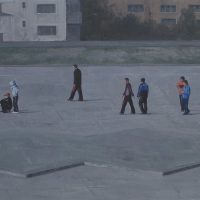Mircea Pinte gyűjtemény, Kolozsvár / Collection Mircea Pinte. Cluj
Photography Studio Protokoll, Cluj
Courtesy Studio Protokoll, Cluj and Plan B, Cluj/Berlin
Courtesy of the artist, and Yvon Lambert Gallery, Paris, Dvir Gallery, Tel Aviv
Institutions: Alergische Platze, Bázis, D Media, IDEA art + society, MindBomb, Paintbrush Factory, Sindan Cultural Center, Tranzit House, Version, Univesity of Art and Design Cluj
Exhibition design: Lundi et Demi
Cluj’s contemporary art has for years been the subject of special international attention. The term Cluj School in reference to new figurative painting – which appeared in the mid 2000s and has been the topic of debate ever since – and the Paintbrush Factory – which houses studios and independent cultural institutions – quickly became widely known in Europe. Of the Cluj artists, many have exhibited in such prestigious international venues as the Stedelijk Museum in Amsterdam, MoMA in New York, the Kunsthaus of Zurich, and the Neuer Berliner Kunstverein. Their works have been discussed in internationally significant publications and they have collaborated with distinguished galleries. The art institutions of Cluj have notable networks of international connections and continuously host prominent foreign experts.
The success story of Cluj is no overnight “miracle” however, as it is a continuously growing, multi-layered phenomenon. Its development and evolution have not only required exceptional artistic talent, inspiration and perhaps a bit of luck, but in the background, are also the result of mostly private initiatives, as well as an immense amount of work, an open attitude, persistence and conscious self-positioning on the part of independent art institutions.
The Mucsarnok exhibition aims to offer an authentic representation of the “Cluj phenomenon.” As a special point of interest, in addition to the artworks, the show also familiarizes viewers with the most important institutions of the local art scene, which are of many different types. These include centres that house contemporary art exhibitions and accommodate theatrical and dance productions, studios that experiment with digital media, publishing projects, as well as community and activist platforms. The University of Art and Design Cluj, with its strong emphasis on building international connections, also makes its appearance. The more than thirty artists and seventeen art groups and institutions that are featured in the exhibition have been selected with a focus on the – internationally also significant – developments in Cluj within the past decade.
The international embeddedness of the contemporary art of Cluj is also well indicated by the fact that a considerable portion of the works has been borrowed from collections in Western Europe. The paintings, graphics, objects, photos, videos and installations featured in the exhibition include both newly realised and site specific works. Similarly to the artist generation of the nineties, albeit with less directness, these artists also react with sensitivity to the challenges of the local social and cultural milieu. The displayed works relate to the mechanisms of history and memory, the ambiguities of the transition period, and the changes in ideology with the same reflectiveness as they do to art history and painting traditions. Figurative painting and critical and lyrical conceptual tendencies – the two defining trends of the contemporary art of Cluj – are represented in a mutually complementing manner at the Mucsarnok.
As part of the special installation of the exhibition, visitors can enjoy an active resting area where they also have access to an abundance of information.



